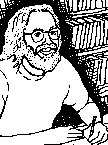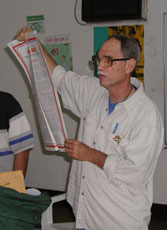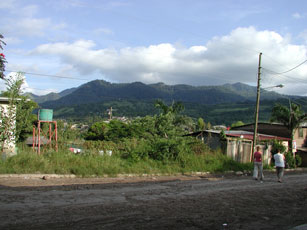

U.S. International Electoral Observation Delegation "Ben Linder"
Friday, November 2. Our delegation gathers at the Sandinista Workers Confederation "José Benito Escobar" (Central Sandinista de Trabajadores "José Benito Escobar," CST/JBE).
 Managua woke up that morning to a significant military presence on the streets. Some people interpreted this as an intimidation tactic by the reigning conservative PLC government to scare voters away from the leftist Frente Sandinista de Liberación Nacional (Sandinista Front for National Liberation, FSLN) because it would remind them of the war years of the 1980s. In any case, by the next morning the soldiers were gone. The elections proceeded for the most part peacefully.
Managua woke up that morning to a significant military presence on the streets. Some people interpreted this as an intimidation tactic by the reigning conservative PLC government to scare voters away from the leftist Frente Sandinista de Liberación Nacional (Sandinista Front for National Liberation, FSLN) because it would remind them of the war years of the 1980s. In any case, by the next morning the soldiers were gone. The elections proceeded for the most part peacefully.
 The leaders of our delegation included Roger Barrantes, Organizational Secretary for the CST/JBE; Paul Baizerman, TecNica; and Andrea Pérez, Secretary of Women's Issues for the CST/JBE.
The leaders of our delegation included Roger Barrantes, Organizational Secretary for the CST/JBE; Paul Baizerman, TecNica; and Andrea Pérez, Secretary of Women's Issues for the CST/JBE.

 Luis Barboza (left) is the Secretary General of the Construction Union of the CST/JBE, and was a candidate for the National Assembly, though he did not win. Miguel Ruiz (right) is the Secretary of International Relations for the CST/JBE.
Luis Barboza (left) is the Secretary General of the Construction Union of the CST/JBE, and was a candidate for the National Assembly, though he did not win. Miguel Ruiz (right) is the Secretary of International Relations for the CST/JBE.
 René Nuñuz is the Organizational Secretary of the FSLN and the second most important person in the party. He won a deputy post in the National Assembly. It was particularly interesting valuable to meet with him, as we were one of the few international groups to do so and he was able to articulate Sandinista positions on a variety of subjects.
René Nuñuz is the Organizational Secretary of the FSLN and the second most important person in the party. He won a deputy post in the National Assembly. It was particularly interesting valuable to meet with him, as we were one of the few international groups to do so and he was able to articulate Sandinista positions on a variety of subjects.
 Jeb Bush, Governor of Florida and brother of United States president George Bush, took out a paid ad in the right-wing newspaper La Prensa on Monday, October 29, stating that the United States supported the conservative candidate Enrique Bolaños of the ruling Liberal Constitutional Party (Partido Liberal Constituciónal, PLC). This as an example of the intimidation tactics that the United States used to get the Nicaraguan people to vote against the Sandinistas. Here is an English translation of the ad.
Jeb Bush, Governor of Florida and brother of United States president George Bush, took out a paid ad in the right-wing newspaper La Prensa on Monday, October 29, stating that the United States supported the conservative candidate Enrique Bolaños of the ruling Liberal Constitutional Party (Partido Liberal Constituciónal, PLC). This as an example of the intimidation tactics that the United States used to get the Nicaraguan people to vote against the Sandinistas. Here is an English translation of the ad.

 We held a press conference in which we denounced U.S. intervention in the elections. Here in the photo are Luiz Barboza and Miguel Ruiz of CST/JBE; Paul Baizerman of Tecnica; Daniel Kovalik, Co-Counsel of the United Steelworkers of America, and Ardenne Bunde from Milwaukee. Dan has worked closely with labor unions in maquilas in Nicaragua. In the picture on the right Jonathan Cloke translates for Chema, who works with a textile federation in Granada, and José Domingo Esquivel, who organizes maquila workers in Managua.
We held a press conference in which we denounced U.S. intervention in the elections. Here in the photo are Luiz Barboza and Miguel Ruiz of CST/JBE; Paul Baizerman of Tecnica; Daniel Kovalik, Co-Counsel of the United Steelworkers of America, and Ardenne Bunde from Milwaukee. Dan has worked closely with labor unions in maquilas in Nicaragua. In the picture on the right Jonathan Cloke translates for Chema, who works with a textile federation in Granada, and José Domingo Esquivel, who organizes maquila workers in Managua.

 Friday afternoon we received training to be electoral observers. Here Lcdo. Mariano Vargas, part of the FSLN international relations team that coordinated international observers, shows us samples of the ballots. As you can see, the ballot was designed to be as simple as possible.
Friday afternoon we received training to be electoral observers. Here Lcdo. Mariano Vargas, part of the FSLN international relations team that coordinated international observers, shows us samples of the ballots. As you can see, the ballot was designed to be as simple as possible.

 Friday evening, Daniel Ortega, presidential candidate for the FSLN, visited our dinner party. Several of us took the opportunity to have our pictures taken with him. Unfortunately, mine did not turn out that well. And, yes, the rumours are true; Daniel does drive himself in his own SUV. I wonder how many presidential candidates do that.
Friday evening, Daniel Ortega, presidential candidate for the FSLN, visited our dinner party. Several of us took the opportunity to have our pictures taken with him. Unfortunately, mine did not turn out that well. And, yes, the rumours are true; Daniel does drive himself in his own SUV. I wonder how many presidential candidates do that.
 Vidaluz Menesis of the Centro Antonio Valdivieso in Managua also joined our dinner and spoke to us about human rights issues.
Vidaluz Menesis of the Centro Antonio Valdivieso in Managua also joined our dinner and spoke to us about human rights issues.

Saturday, November 3. We traveled to Matagalpa in northern Nicaragua where we would observe the elections. While in Matagalpa, we visited the grave of Ben Linder after whom our delegation was named.

Sunday, November 4. Election Day. Most voters faced long lines at the polling stations all day long. Despite an unusually hot day even in the mountains of Matagalpa, turnout was high with about 90% of the elgible population voting. We observed the elections in the rural community of Solingalpa outside of the city of Matagalpa. For more detailed information on what we observed during the voting, see our Matagalpa Delegation Report. Basically, the voting process went like this:
 A voter enters the classroom which serves as the polling station and presents a "cedula" or identification card. The president of the electoral table was supposed to scan the card with a blacklight to verify the validity of the card. The first member of the table checked the name against an official voting list.
A voter enters the classroom which serves as the polling station and presents a "cedula" or identification card. The president of the electoral table was supposed to scan the card with a blacklight to verify the validity of the card. The first member of the table checked the name against an official voting list.
 The president was then supposed to scan the voter's thumb for evidence of ink which would indicate that this person had already voted. We observed numerous times that this step was skipped.
The president was then supposed to scan the voter's thumb for evidence of ink which would indicate that this person had already voted. We observed numerous times that this step was skipped.
 Sometimes the election workers needed to consult a map to verify that the voter actually lived in that district.
Sometimes the election workers needed to consult a map to verify that the voter actually lived in that district.
 After the president explained to each voter how to fill out the ballot, the voter proceeded to a cardboard box that served as the voting booth.
After the president explained to each voter how to fill out the ballot, the voter proceeded to a cardboard box that served as the voting booth.
 The voter would then fold the ballot in half and place it in the boxes for each of the four races.
The voter would then fold the ballot in half and place it in the boxes for each of the four races.
 Finally, the voter would return to the electoral table where the second member would ink the voter's thumb and punch a hole in the identification card in order to prevent that person from voting again.
Finally, the voter would return to the electoral table where the second member would ink the voter's thumb and punch a hole in the identification card in order to prevent that person from voting again.
 At 2 p.m., we observed three military helicopters flying overhead. Apparently there were carrying U.S. Representatives from the International Republican Institute from a military base in Honduras to observe the elections in Jinotega and Matagalpa before continuing on down to Managua.
At 2 p.m., we observed three military helicopters flying overhead. Apparently there were carrying U.S. Representatives from the International Republican Institute from a military base in Honduras to observe the elections in Jinotega and Matagalpa before continuing on down to Managua.
 Quarter to six, the sun has set, and there are still lines at all of the polling stations. None of the polls manage to close at 6 p.m.
Quarter to six, the sun has set, and there are still lines at all of the polling stations. None of the polls manage to close at 6 p.m.

 6:45 p.m., and the counting of the vote begins. This laborious task would last until after midnite for our polling station, and until 4 a.m. for another polling station at the school. First the votes needed to be separated into piles for each vote.
6:45 p.m., and the counting of the vote begins. This laborious task would last until after midnite for our polling station, and until 4 a.m. for another polling station at the school. First the votes needed to be separated into piles for each vote.

 Then, under the careful eye of the fiscales and observers, the votes were separated by party and counted. Finally, the vote tallies were listed on the official report forms, and the ballots were sealed in envelops.
Then, under the careful eye of the fiscales and observers, the votes were separated by party and counted. Finally, the vote tallies were listed on the official report forms, and the ballots were sealed in envelops.

4 a.m. and we finally are ready to carry the votes into the municipal electoral council in Matagalpa where the totals will be reported to the Supreme Electoral Council (CSE) in Managua.
